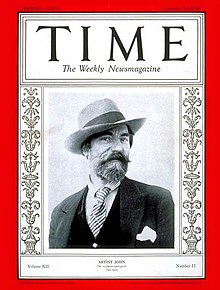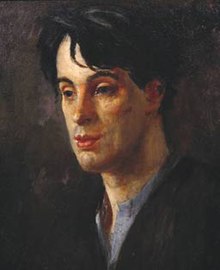Augustus John

Augustus Edwin John OM, RA, (January 4, 1878 – October 31, 1961) was a Welsh painter, draughtsman, and etcher. For a short time around 1910, he was an important exponent of Post-Impressionism in England.
"Augustus was celebrated first for his brilliant figure drawings, and then for a new technique of oil sketching. His work was favourably compared in London with that of Gauguin and Matisse. He then developed a style of portraiture that was imaginative and often extravagant, catching an instantaneous attitude in his subjects."[1]
Life and work
Education
John was born at Tenby in Pembrokeshire, the younger son and third of four children in his family. His father was Edwin William John, a Welsh solicitor; his mother, Augusta Smith, died young, but not before inculcating a love of drawing in both Augustus and his older sister Gwen.[2] At the age of seventeen he briefly attended the Tenby School of Art, then studied at the Slade School of Art UCL in London (his sister, Gwen, was with him at the Slade and became an important artist in her own right),[3] where he became the star pupil of drawing teacher Henry Tonks, and even before his graduation was recognized as the most talented draughtsman of his generation.[4]

In 1897 John was seriously injured while swimming, and the lengthy convalescence that followed seems to have actually stimulated his adventurous spirit and accelerated his artistic growth.[5] In 1898, he won the Slade Prize with Moses and the Brazen Serpent. John afterward studied independently in Paris where he seems to have been influenced by Puvis de Chavannes.[6]
Provence
Some time in 1910, John fell in love with the town of Martigues, in Provence. "Glimpsed from a train en route to Italy, John referred to this enchanting town on the banks of the Etange de Berre as 'the goal of my dreams', and would return regularly with his family to stay at the Villa Ste Anne for the next eighteen years. Characteristically, it was not only the colour and beauty of the Provencal landscape that delighted John, but also that of the handsome local population. In a letter to Ottoline Morrell written shortly after his first arrival in Martigues, Augustus remarked, '... I have seen so many powerful women whose essential nudity no clothing can disguise.'"[7]
He was, throughout his life, particularly interested in the Roma people (whom he referred to as Gypsies), and sought them out on his frequent travels around the British Isles and Europe. For a time, shortly after his marriage, he and his family travelled aound in a caravan, in gypsy fashion.
War
During World War I, he was attached to the Canadian forces as a war artist and made a number of memorable portraits of Canadian infantrymen. The end result was to have been a huge mural for Lord Beaverbrook and the sketches and cartoon for this suggest that it might have become his greatest large-scale work. However, like so many of his monumental conceptions, it was never completed. As a war artist, "he was also allowed to keep his facial hair and therefore became the only officer in the Allied forces, except for King George V, to have a beard. After two months in France he was sent home in disgrace after taking part in a brawl. Lord Beaverbrook, whose intervention saved John from a court-martial, sent him back to France but he is only known to have completed one painting, Fraternity."[8]
Portraits
Although well-known early in the century for his drawings and etchings, the bulk of John's later work consisted of portraits, some of the best of which were of his two wives and his children. He was known for the psychological insight of his portraits, many of which were considered "cruel" for the truth of the depiction. Lord Leverhulme was so upset with his portrait that he cut out the head (since only that part of the image could easily be hidden in his vault) but when the remainder of the picture was returned by error to John there was an international outcry over the desecration.[9]
By the 1920s John was Britain's leading portrait painter. John painted many distinguished contemporaries, including T. E. Lawrence, Thomas Hardy, W.B. Yeats, George Bernard Shaw, the cellist Guilhermina Suggia, the Marchesa Casati and Elizabeth Bibesco. Perhaps his most famous portrait is of his fellow-countryman, Dylan Thomas.
It was said that after the war his powers diminished as his bravura technique became sketchier. One critic has claimed that "the painterly brilliance of his early work degenerated into flashiness and bombast, and the second half of his long career added little to his achievement." However, from time to time his inspiration returned, as it did on a trip to Jamaica in 1937.[10] Those works that "relate to his visit to the West Indies in 1936-7 show just how undiminished his abilities were. The rendering of light and shade beneath the tall palms, and the easy suggestion of movement in the lightly brushed figures, all bespeak an artist whose powers were anything but diminished, harking back to the many descriptions which lauded him as the finest draughtsman since the Old Masters".[11]
Of his method for painting portraits John explained:
" Make a puddle of paint on your palette consisting of the predominant colour of your model's face and ranging from dark to light. Having sketched the features, being most careful of the proportions, apply a skin of paint from your preparation, only varying the mixture with enough red for the lips and cheeks and grey for the eyeballs. The latter will need touches of white and probably some blue, black, brown, or green. If you stick to your puddle (assuming that it was correctly prepared), your portrait should be finished in an hour or so, and be ready for obliteration before the paint dries, when you start afresh."[12]
Family
By his first wife, Ida Nettleship (1877–1907), he had five children, and by his mistress Dorothy "Dorelia" McNeill, who later became his second wife, he had two children. One of his sons was the prominent British Admiral and First Sea Lord Sir Caspar John. By Ian Fleming's widowed mother, Evelyn Ste Croix Fleming née Rose, he had a daughter, Amaryllis Fleming (1925–1999), who became a noted cellist.
Later life
In later life, John wrote two volumes of autobiography, Chiaroscuro (1952) and Finishing Touches (1964).[13] In old age, although John had ceased to be a moving force in British art, he was still greatly revered, as was demonstrated by the huge show of his work mounted by the Royal Academy in 1954. He continued to work up until his death in Fordingbridge, Hampshire in 1961, his last work being a studio mural in three parts, the left hand of which showed a Falstaffian figure of a French peasant in a yellow waistcoat playing a hurdy gurdy while coming down a village street. It was Augustus John's final wave goodbye.
He is said to have been the model for the bohemian painter depicted in Joyce Cary's novel The Horse's Mouth, which was later filmed with Alec Guinness in the lead role.[14]
Michael Holroyd published a biography of John in 1975 and it is a mark of the public's continued interest in the painter that Holroyd published a new version of the biography in 1996.
Honours
He became a leader of the New English Art Club, where he chiefly exhibited. With his vivid manner of portraiture and his ability to catch unerringly some striking and usually unfamiliar aspect of his subject, he superseded Sargent as England's fashionable portrait painter. In 1921 he was made a member of the Royal Academy.
See also
Notes
- ^ http://www.bbc.co.uk/wales/arts/sites/art/pages/gwen_augustus_john.shtml
- ^ Easton, Malcolm, and Holroyd, Michael: The Art of Augustus John, page 1. David R. Godine, 1975.
- ^ One of "a bevy of talented girls" there at the time. Easton and Holroyd, page 2.
- ^ As witness "The legendary Slade acclamation, 'There was a man sent from God, whose name was John'". Easton and Holroyd, page 2.
- ^ Easton and Holroyd, page 2.
- ^ http://en.wikipedia.org/wiki/New_International_Encyclopedia
- ^ http://www.waterman.co.uk/pages/single/1569.html
- ^ http://www.waterman.co.uk/pages/biography/91.html
- ^ James Joyce complained that John's drawings of him "failed to represent accurately the lower part of his face", and commenting on Lady Ottoline Morrell's determination to hang her portrait in her drawing-room, John observed "Whatever she may have lacked, it wasn't courage." Easton and Holroyd, pages 186, 82.
- ^ The Two Jamaican Girls, by Augustus John (1878 - 1961)
- ^ http://www.waterman.co.uk/pages/single/306.html
- ^ Easton and Holroyd, page 156.
- ^ http://www.waterman.co.uk/pages/biography/91.html
- ^ http://www.imdb.com/title/tt0051739/ The Horses's Mouth (1958)
External links
- Augustus John collection at the Tate Gallery
- Augustus John collection at the National Portrait Gallery London
- Augustus John collection at the National Museum Wales
- Article about Gwen and Augustus John in BBC Wales
- John's prize-winning painting Study for Moses and the Brazen Serpent
- Portraits of Elizabeth Asquith by John and others
- John's sketch of the writer, James Joyce
- John's connection with the anarchist movement from libcom.org
